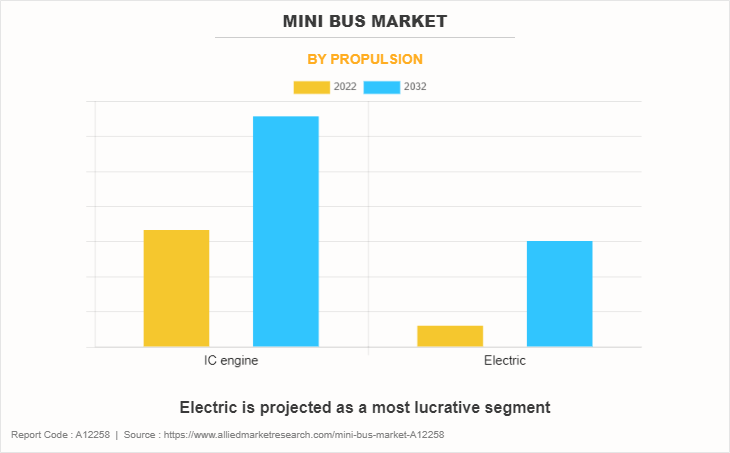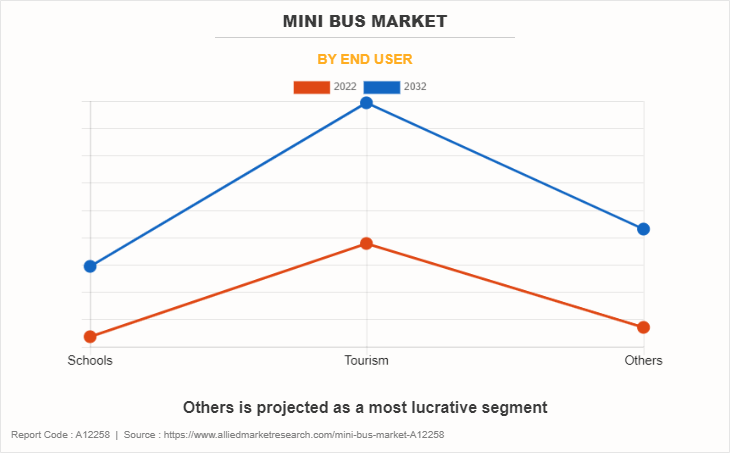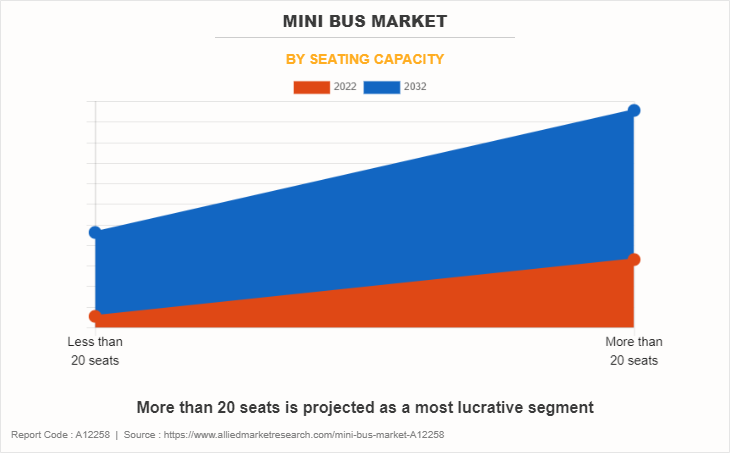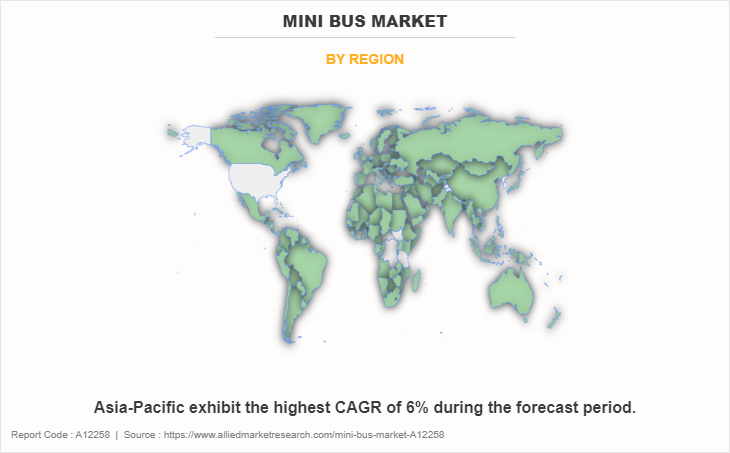Minibus Market Overview
The global minibus market size was valued at $9.9 billion in 2022, and is projected to reach $15.6 billion by 2032, growing at a CAGR of 4.7% from 2023 to 2032.
Report Key Highlighters:
- The study covers regions such as North America, LAMEA, Europe, and Asia-Pacific. The research includes regional and segment analysis of each country in terms of value ($million) for the projected period 2023-2032.
- The study integrated high-quality data, professional opinions and analysis, and critical independent perspectives. The research approach is intended to provide a balanced view of global markets and to assist stakeholders in making educated decisions in order to achieve their most ambitious growth objectives.
- Over 3,700 product literature, annual reports, industry statements, and other comparable materials from major industry participants were reviewed to gain a better understanding of the market.
- The minibus market share is highly fragmented, into several players including Mercedes-Benz Group AG, Ford Motor Company Ltd, Hyundai motor company, MAN, TATA motors, TOYOTA MOTOR CORPORATION, Marcopolo SA, Volkswagen Group, Karsan Otomotiv Sanayii ve Ticaret A.S., IVECO S.p.A. The companies have adopted strategies such as product launches, contracts, expansions, agreements, and others to improve their market positioning.

A minibus is a compact vehicle used for passenger transportation that carries a small group of people. The seating capacity of the vehicle is up to 40. These vehicles are frequently used for a range of transportation purposes, including taking groups of people on short to medium distance trips within cities or to airports. It provides a middle ground as they have the space for larger buses and the mobility of a smaller vehicle. They are available in a variety of configurations, such as 1-door, 2-door, regular roof, and high-top variants. Minibuses in suburban and urban transportation provide maneuverability and easily fit through congested urban streets and into spaces that are difficult for bigger vehicles to access.
Internal combustion (IC) engines or electric propulsion systems are frequently used in minibuses. Minibuses with IC engines employ conventional fuel combustion to produce power, which is an established and reliable propulsion method. The transportation sector has adopted electric propulsion and shifted to the use of more environmentally friendly energy sources to comply with the strict regulations. Electric minibuses, which include electric motors driven by rechargeable batteries, offer a more sustainable and environmentally friendly form of transportation. The introduction of electric propulsion systems, advancements in safety features, and large seating capacities are some of the minibus market trends that are being adopted by the automotive sector to stay competitive in the market.
In the tourism industry, it is commonly used for guided tours. It offers tourists a convenient and comfortable way to explore popular attractions and scenic locations. These vehicles provide flexibility in accessing tourist destinations, making them an integral part of the tourism infrastructure in many regions. Whereas minibuses in school transportation provide a safe and efficient means of conveying students to and from educational institutions.

Minibuses are also utilized for various other activities, such as corporate events, airport transfers, community transportation services and functions such as marriage, and shuttle services for hotels and resorts. Their versatility and ability to accommodate small to medium-sized groups make them well-suited for a wide range of transportation needs beyond traditional public transit.
The minibus market is expected to expand with urbanization and growth in tourism and recreational activities. Urbanization contributes to the growth of minibuses in several ways. As cities expand and populations concentrate in urban areas, the demand for efficient and flexible transportation options increases and there is a greater need for reliable and accessible public transit systems to accommodate the growing population.
With urbanization comes the growth of a city. As a city grows, infrastructure development becomes crucial, including the development of transportation networks and systems to accommodate the growing urban population. The development provides the roads connecting cities to villages and the need for accessible and ecologically friendly transit options as well as efficient and sustainable transportation. One important solution to these challenges is the usage of minibuses. Therefore, the market grows with the growth of any city or sub urban area.

Minibuses serve as versatile and practical transportation solutions, offering efficient and comfortable travel options for diverse purposes, including school transportation, tourism, and a wide array of other activities. Whether powered by IC engines or electric propulsion systems, minibuses continue to play a significant role in meeting the transportation needs of communities and organizations worldwide.
The minibus market is segmented into propulsion, end user, seating capacity, and region. By propulsion, the market is bifurcated into IC engine, and electric. By end user, the market is classified into school, tourism, and others. By seating capacity, the market is bifurcated into less than 20 seats and more than 20 seats. By region, the market is analyzed across North America, Europe, Asia-Pacific, and LAMEA.
The key players in the minibus market include Mercedes-Benz Group AG, Ford Motor Company Ltd, Hyundai motor company, MAN, TATA motors, TOYOTA MOTOR CORPORATION, Marcopolo SA, Volkswagen Group, Karsan Otomotiv Sanayii ve Ticaret A.S., IVECO S.p.A.
Key Developments in Minibus Industry
The leading companies are adopting strategies such as acquisition, agreement, expansion, partnership, contracts, and product launches to strengthen their market position.
- In December 2023, Tata motors achieved central motor vehicle rule (CMVR) certification for its hydrogen fuel cell starbus. The certification is expected to help the company facilitate the road authorization of the bus.
- In June 2023, Marcopolo is developing an autonomous minibus in partnership with Lume Robotics. The development shows the company's shift towards autonomous vehicle which is expected to attract new customers for the company.
- In May 2023, Ford Motor company expanded its e-minibus transit to the UK. The product expansion is expected to gather new customers for the company in the UK and nearby region.
- In May 2023, Hyundai updated its minibus county. The bus has new dashboard and available in two variants known as long body with 29 seats and extra-long body with 600mm more length and seating capacity up to 32 passengers. The upgrade is expected to increase its portfolio and attract new customers.
Urbanization in minibus industry
Urbanization drives the sales of minibuses through the increasing demand for efficient and adaptable urban transportation solutions. As cities expand and populations concentrate in urban areas, the need for accessible public transport escalates. Minibuses, with their maneuverability and capacity to navigate congested city streets, have become a vital component of urban mobility. For example, in rapidly growing cities such as Jakarta, Indonesia, where traffic congestion is a significant issue, minibuses play a pivotal role in providing last-mile connectivity and serving areas inaccessible to larger buses. Furthermore, as urban infrastructure evolves, minibuses are better suited to navigate narrower roads and reach areas with limited parking space. This adaptability makes them an attractive option for urban transportation, further fueling their sales in response to the demands of urbanization.
Growth in tourism and recreational activities
The growth in tourism and recreational activities has a significant impact on the sales of minibuses, as these vehicles cater to the transportation needs of tourists and outdoor enthusiasts. As tourist destinations become more popular and recreational activities gain traction, the demand for convenient and efficient transportation solutions rises. Minibuses, with their capacity to accommodate a medium-sized group of people, become an ideal choice for tour operators, adventure companies, and recreational facilities. Moreover, tour operators offering wine tours, cultural excursions, and group transportation to events also contribute to the increased sales of minibuses. The versatility and practicality of minibuses make them an essential asset for businesses looking to cater to the growing demand for tourism and recreational experiences, thereby driving their sales in these flourishing industries.

License restrictions
License restrictions significantly hinder the market growth of minibuses by creating barriers for potential buyers and operators. In many places, obtaining the necessary licenses to operate a minibus be complex and costly, leading to a limited pool of qualified drivers and operators. In addition, specific license requirements for operating minibuses, such as passenger endorsements or commercial driving licenses, deter individuals and businesses from investing in these vehicles. Moreover, the stringent regulations and compliance standards associated with minibus operation further restrict market growth, as businesses find it challenging to navigate the legal requirements and associated costs. License restrictions create a challenging environment for the market growth of minibuses by limiting the accessibility, affordability, and operational flexibility of these vehicles, thereby hampering their potential to meet the evolving needs of the transportation industry.
Government regulations
Government regulations play a pivotal role in shaping the future opportunities for the minibus industry by establishing standards, promoting sustainable practices, and fostering innovation to meet evolving transportation needs. Through stringent emission norms, safety standards, and public transportation policies, governments incentivize the adoption of eco-friendly and efficient minibuses, creating a conducive environment for market expansion and technological advancement. For instance, government initiatives aimed at reducing carbon emissions and promoting clean energy leads to increased investment in electric and hybrid minibuses. Subsidies, tax incentives, and grants for manufacturers and operators transitioning to low-emission vehicles present a compelling opportunity for the minibus industry to embrace sustainable technologies and contribute to environmental conservation. In addition, stringent safety regulations mandating the implementation of advanced safety features, such as emergency braking systems and driver assistance technologies, drive innovation and elevate the safety standards of minibuses, enhancing their appeal to passengers and stakeholders.

Impact of Recession on minibus market
During a recession, the minibus market faces significant challenges as consumer and business spending contracts. In an economic downturn, businesses reduce non-essential travel, leading to decreased demand for minibus services for corporate events, team outings, and employee transportation. Similarly, individuals cut back on leisure activities and discretionary spending, impacting the demand for minibus rentals for group outings or events. Moreover, the recession limits the financial capacity of minibus operators to invest in fleet expansion or maintenance, potentially leading to a decrease in vehicle purchases and overall market activity. However, amidst the challenges, there could be opportunities for minibuses to serve as cost-effective alternatives to individual car ownership and larger public transit systems.
Key Benefits For Stakeholders
- This report provides a quantitative analysis of the market segments, current trends, estimations, and dynamics of the minibus market analysis from 2022 to 2032 to identify the prevailing market opportunities.
- The market research is offered along with information related to key drivers, restraints, and opportunities.
- Porter's five forces analysis highlights the potency of buyers and suppliers to enable stakeholders make profit-oriented business decisions and strengthen their supplier-buyer network.
- In-depth analysis of the market segmentation assists to determine the prevailing market opportunities.
- Major countries in each region are mapped according to their revenue contribution to the global market.
- Market player positioning facilitates benchmarking and provides a clear understanding of the present position of the market players.
- The report includes the analysis of the regional as well as global market trends, key players, market segments, application areas, and market growth strategies.
Minibus Market Report Highlights
| Aspects | Details |
| Market Size By 2032 | USD 15.6 billion |
| Growth Rate | CAGR of 4.7% |
| Forecast period | 2022 - 2032 |
| Report Pages | 396 |
| By Propulsion |
|
| By End User |
|
| By Seating Capacity |
|
| By Region |
|
| Key Market Players | Hyundai Motor Company, Ford Motor Company, FORCE MOTORS Ltd, Mercedes-Benz Group AG, Karsan Otomotiv Sanayii ve Ticaret A.?., Tata Motors, Volkswagen Group, IVECO S.P.A, Marcopolo SA, TOYOTA MOTOR CORPORATION |
Electric propulsion minibuses are the upcoming trends in the market.
Tourism is the leading application of minibus market.
Asia-Pacific is the largest regional market for minibus.
The global minibus market was valued at $9,913.69 million in 2022, and is projected to reach $15,579.01 million by 2032, registering a CAGR of 4.7% from 2023 to 2032.
The key players in the minibus market include Mercedes-Benz Group AG, Ford Motor Company Ltd, Hyundai motor company, MAN, TATA motors, TOYOTA MOTOR CORPORATION, Marcopolo SA, Volkswagen Group, Karsan Otomotiv Sanayii ve Ticaret A.?., IVECO S.p.A.
Loading Table Of Content...
Loading Research Methodology...



